One of the most magical and exciting encounters Panama holds is the sighting of one of the sea’s largest mammals, the humpback whale. These whales migrate to Panama every year, escaping cold northern or southern waters to mate or give birth.
It is difficult to resist the tenderness that these gigantic cetaceans radiate, especially when the mother and the newborn baby swim near us, or to be surprised to see a 40-ton bus literally fly through the air, or to learn more about their love songs.
These are 15 questions that always ask us and surely you think about it too, for your next whale watching tour.
1. Where does the name humpback come from?

Humpbacks don’t normally have a hump on their backs; the name comes from the large hump that forms when they arch their backs before making a deep dive into the ocean.
Its long pectoral fins inspired its scientific name, Megaptera, which means “big-winged” and novaeangliae, which means “New England,” is about where European whalers’ location first encountered them.
They’re incredible acrobats.
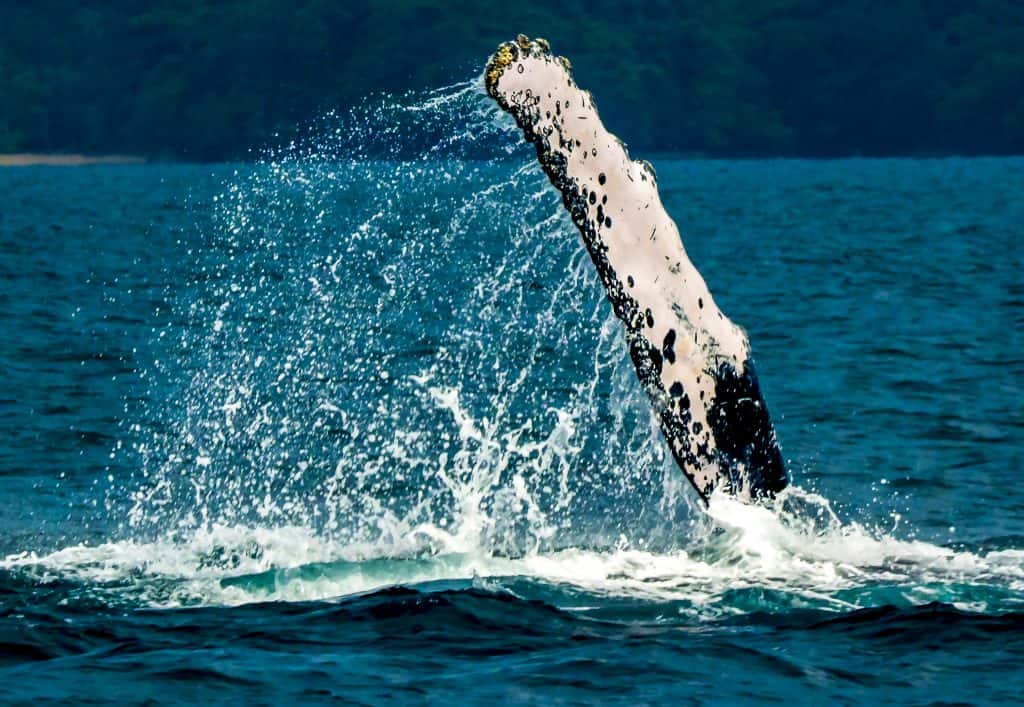
Few creatures can cause the sentiment of awe in humans, like a 40-ton whale breaching out of the water. The capture stays on our minds as if the whale levitates in the air.
In the humpback’s playbook of surface antics, which include pectoral fin slapping, tail-lobbing, chin-slapping, cartwheeling, and spy hopping.
Little wonder that Herman Melville, author of Moby Dick, called them “the most gamesome and light-hearted of all the whales.”
2. How big are humpback whales?
- Humpback whales are gigiant creatures — about the size of a school bus.
- They can grow to 60 feet (18 meters) long, and they can weigh a whopping 40 tons
- Their flippers can grow up to 16 feet (5 m) long, which is the longest flippers in the whale world — or the longest arms on the planet, a third of the body length. Their tails are also massive and grow up to 18 feet (5.5 m) wide.
- The average humpback heart, for example, weighs about 200 kg as much as three adult humans!
- Like most whales, females are larger than males.
3. Is a whale’s a fountain of water?
Contrary to popular belief, that’s not seawater. Both whales and people use their lungs and noses to breathe air.
The telltale spouts that are formed on the surface occur when whales expel warm air that meets colder air on the surface and condenses into small water droplets.
This condensed water vapor looks like steam – the same thing happens when you “see your breath” on a cold winter day, which gives the mistaken impression that it is predominantly expelled water. The odor is an unholy mingling of fart and fishiness.
A Humpback’s spouting can reach as high as 3 meters and can be heard as far as 250 meters away.
4. Really!, Does the whales have a nose?
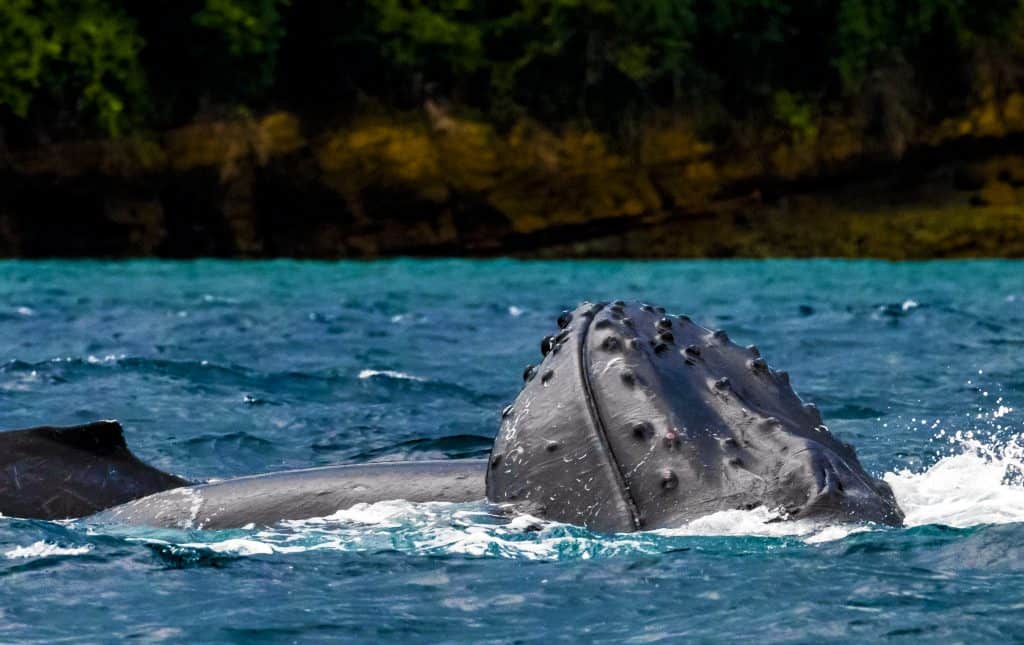
The modified nostril is located on the top of a whale or dolphin’s head. During dives, the blowhole is sealed by a nasal plug which is retracted by fast-acting muscles upon surfacing for breathing. Baleen whales have two openings in their blowhole, while toothed whales have only one.
The olfactory organs of humpback whales are greatly reduced, but they have a sense of smell.
5. How long can Humpback Whales hold the breath?
Remember, they are not fish, they breathe like us, they have huge lungs. They can stay underwater for 30 minutes, but they usually come out to breathe every 15 minutes. Humpbacks dive to about 200 m.
These marine giants have a highly efficient breathing system that allows them to absorb up to 90 percent of the 200 liters of oxygen they inhale, compared to just 15 percent of humans do.
6. What do humpback whales eat?
These giants cetaceans mostly eat tons of krill, small crustaceans, they love eating plankton, and also other small invertebrates like small schooling fishes such as anchovies, sardines, and mackerel.
Humpback Whales belong to the family of baleen wheels, which have a series of curtain-like filters in their mouths instead of teeth. Rather than chew their food, humpbacks swallow it all, expelling what they won’t digest.
To eat prey, they take large gulps of water. Below the mouth are 12 to 36 throat grooves that expand to hold the water. The baleens filter the water, and the two blowholes on the whale’s back expel the water. The fish and other goodies remain in the whale for digestion.
Humpbacks are also very good pack hunters. When a pod is on the hunt, some members will blow air bubbles around a school of feeder fish, trapping them in a rough cylinder, and use air bubbles to herd, corral or disorient fish. This ingenious cooperative method to trap fish is called ‘bubble netting’.
The bubbles confuse the fish and krill, concentrating them at the surface, and making an easy feast for the whales.
These whales can consume about 1 ton (2,000 lbs.) of food during a single day!
They will usually do all of their feedings in the summer months, living for the most part off of their reserves of fat during the winter. This means that they practically do not feed while they make their long migrations.
7. Could a Humpback Whale swallow a person?
There is no doubt that they have the largest mouth in the animal kingdom. An average-sized humpback can take in around 20,000 liters of water at one time.
To put that into perspective, that’s enough to fill a small pool and more than enough to suck in a person that’s snorkeling nearby or a scuba diver that’s in the vicinity. But they have a small esophagus and therefore aren’t capable of swallowing large prey.
Lucky for us, a standard-sized human adult is far too big to fit down the esophagus of a whale, which means the whale would spit you back out.
8. How are baby whales like?
When the word ‘baby’ is placed before any animal, it’s easy to imagine how precious and adorable the new life is. The same is true for baby humpback whales.
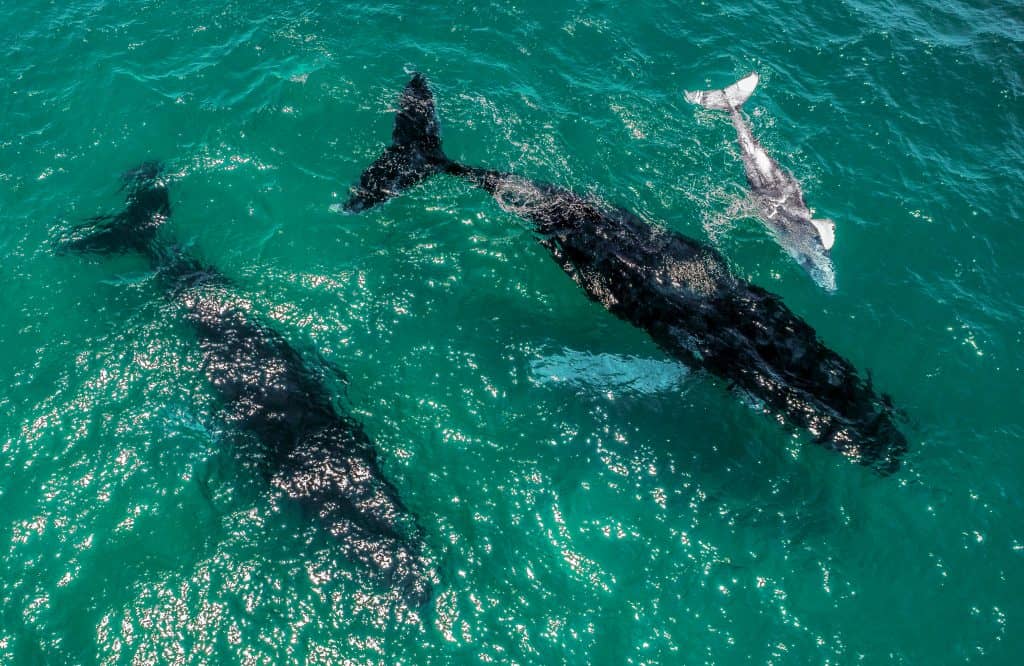
Humpback mothers are loving and attentive, and it’s a once-in-a-lifetime experience to see the mothers with their babies. It makes you wonder.
The pregnancy lasts about 11 months. Unlike any other kind of baby, a Humpback calf weighs about 900 kg at birth and is about 3 to 4.5 meters long. Once the calf is born, the color is a pale grey, but quickly darkens within a few days of being birthed.
The calves keep growing until they are ten years old.
Because whales are mammals, their calves grow inside their mothers and are born through live births. During the whale birth process, calves will emerge tail-first so that they don’t drown during the process. Once a female whale gives birth, it typically nudges its calf up to the ocean surface, so it can take its first breath.
During the first month of life, many whale calves will not sleep, meaning mother whales will have to forget sleep as well to keep a watchful eye on them.
These ocean babies are hungry, drinking as much as 45 kg (600 liters) of their mother’s milk a day, during their first year of life, baby humpback whales are nursed and fed milk from their mother. This milk the babies are fed from their mothers is thick, yogurt-like, and made up of 40-60% fat.
During their first year, baby whales can stay underwater for only a few minutes at a time. To be breastfed they must immerse themselves in water and stand under their mother to suckle. Baby whales cannot breathe and nurse at the same time, so nursing periods tend to be short (range 15 to 55 seconds).
When they are born don’t have a fat deposit, they need to gain weight fast, it is all needed as the feeding helps the baby build up their blubber layer so they can safely travel back to the Antarctic feeding grounds.
Like humans, just after about seven months, the humpback babies are weaned onto solid food. But, will continue to feed off the milk for up to 2 years.
The shape and color pattern on the dorsal fin and flukes is unique to each individual, like human fingerprints. That discovery has helped researchers identify, catalog, and monitor humpback whale migration, population size, sexual maturity, and behavior patterns.
Humpbacks are good and protective moms
Mum-duty starts right away with these creatures; as soon as the birthing process is over, To protect them from predators, mum will position baby over her head while swimming. If any male whale begins approaching, mum will place herself between the other whale and baby, as the males will push the babies out of the way to mate with her.
In a few days, the adventurous calf will start swimming and attempt to dive or even head lunge. They alternate between bouts of energetic flipping and flopping around the mother, then resting quietly tucked under her flipper or chin, or riding (slipstreaming) above her mouth.
Even more remarkable is that mom nurses while eating nothing herself. In tropical waters, there’s nothing for her to eat. She’ll lose up to one-third of her body weight before she can get back to temperate waters in the spring to feed.
Mum will never be far because she knows the baby is already filled with curiosity and intelligence and will try to explore.
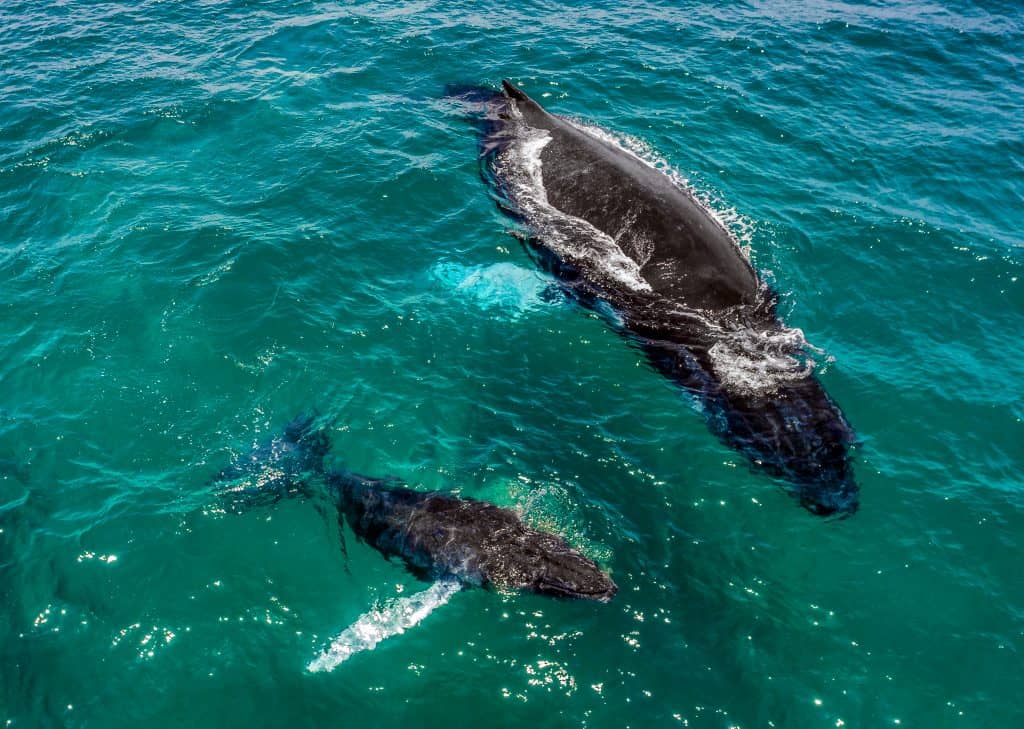
In the past, it was thought that only males sing, now we know that mothers also sing softly to their babies and whisper too, possibly to snuggle them.
Calves also whisper to let their mothers know where they are while being caressed under their mother’s fin.
They do this gently to avoid attracting the predators’ attention.
Remember, do not disturb a mother and her calf, the maximum observation time is 15 min. Most importantly, do not chase them, they will feel distressed.
9. How long do humpback whales live?
The average lifetime is about 50 years, however, there have been indications of much longer lifespans, almost 80 years in some cases.
The age of one individual is estimated by counting growth layers in the teeth (article in French only), in the baleen, or even in the ear wax of the carcass.
10. Where humpback whales live?
There are found almost in every ocean in the world. Humpbacks love to travel and make a long migration twice every year. They move their residence from the cooler polar water in summers to feed, then to warmer tropical waters in the winter to breed, closer to the Equator.
Panama is one of the few countries in the world that hosts humpback whales from both the Northern and Southern Hemispheres.
Between July to October several hundred whales visit Panama’s Pacific coast after feeding in Antarctica and Chile during the Southern Hemisphere summer months.
Between December and April, Northern Hemisphere whales descend to Panama to breed after feeding in California, Oregon, and Washington.
Over 30 species of whales and dolphins have been documented in Panama’s waters, offering whale watchers the opportunity to observe many different species.
11. How fast can Humpback Whales swim?
When traveling, humpback whales move at about 5 to 15 km per hour. During feeding, they’ll slow to 2 to 5.5 km/h. When they want to really move they can speed up to about 25 km/h.
Humpbacks are powerful swimmers, and they use their massive tail fin, called a fluke, to propel themselves through the water and sometimes completely out of it. These whales, like others, regularly leap from the water, landing with a tremendous splash.
They’re marathon travelers.
Humpback whales undertake one of the longest migrations of any mammal, with some individuals making an amazing trip of 8,000 km twice a year. From the Poles to Panama and return.
12. Do the humpback whales travel in groups?
Humpback whales are social animals, they work together as a pack to hunt and feed, they even help the weakest to feed, but don’t travel in tight-knit social groups. They are also known to make friends with members of other species, even leading to defending them from predators.
Humpbacks typically travel alone or in small groups, called pods, consisting of two or three whales, the basic social group consists of the cow (female), a single calf, and the “escort” male. Escorts do little to help raise the calves because their primary attention is directed to mating and fending off other males. Sometimes they keep temporary groups of more individuals.
Mothers and their young swim close together, they communicate with each other, often touching one another with their flippers with what appear to be gestures of affection.
They even learn together the new versions of their songs every year and share experiences, which are passed from generation to generation, there is no doubt that they are extremely intelligent.
Let the battle begin!
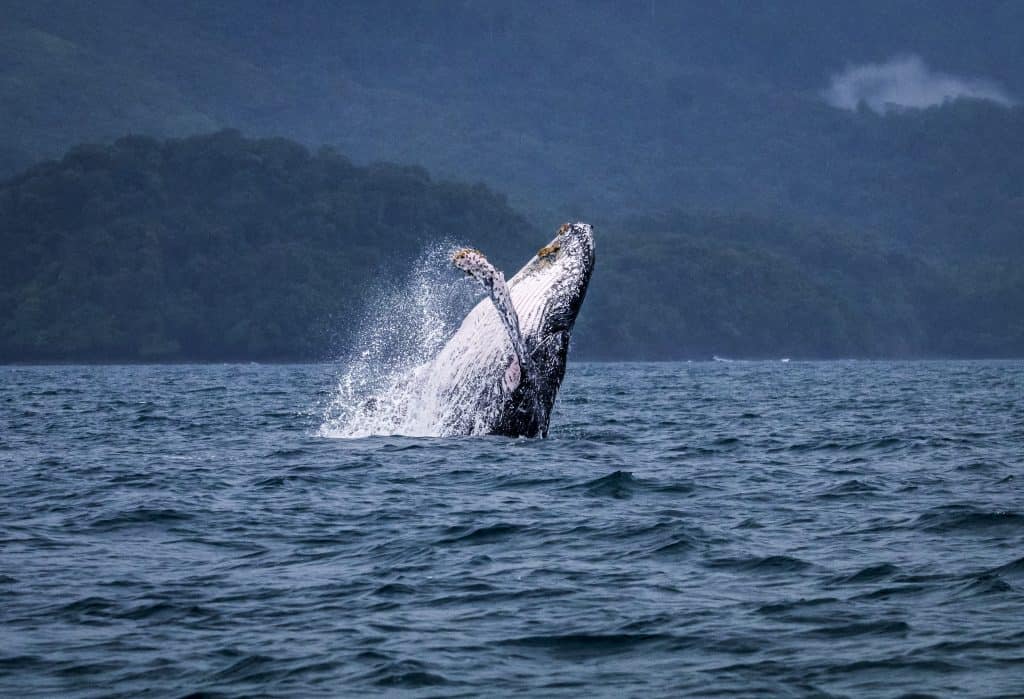
When two or more bachelor’s males show interest in the same female, mating competition can become intense and the fireworks begin. Multiple testosterone-fueled giants plunge through the waves in pursuit of the female, males Humpbacks have been witnessed using glancing rostrum blows, lateral fluke swipes, bubble streaming, jostling, tail-slashing, head lunging, various vocalizations during mating challenges, and head-butting each other to usurp the escort and be the chosen one for fatherhood.
Scars and gouges are common amongst adult males; some display dorsal fins that have been sheared off during past confrontations. These competitions can range in size from two whales to two dozen and are an amazing sight to witness, that disband after a few hours, although longer-term associations have been observed.
13. Why do the Humpback Whales sing?
Whales don’t have vocal cords. Instead, they make sounds internally by squeezing air through sinuses and connecting passageways. It’s a pretty neat trick, especially for male humpbacks, who as it turns out are crooners extraordinaire.
They’re virtuoso singers, Humpback whales are known to be songsters of the sea. Humpback whales sing some of the longest and most complex songs in the animal kingdom. The exact function of humpback songs is not known, but there are many theories.
Singing also plays a part in reproduction. It is thought that males use songs to attract the female, as well as to show dominance. It may also have an important role in inducing oestrus in females. It could also act as a challenge to other males. Yet another theory is that it has an echolocation function, acting as a sonar so that the whales can ‘see’ and navigate around their environment.
Sure, when you first listen to these songs they sound like a bunch of random whines, squeals, grunts, moans, howls, and cries. But they’re not random. At the breeding grounds, all males in a population sing the same song, sometimes for up to 30 minutes, repeating themes and phrases in a particular order. Each population’s song is different and changes slightly over time.
As it is the male that produces the long complex songs (females have shorter vocalizations), Male humpback whales are well-known for their loud, haunting songs, but researchers have discovered that mothers and their calves ‘whisper’ to each other. It is thought that quiet communication reduces the risk of being overheard by orcas, which hunt humpback whale calves.
14. Are Humpback Whales Dangerous?
Humpback whales are gentle and non-aggressive animals by nature, so it’s very unlikely for them to do any harm to a human. They are very large and curious, sometimes they will approach boats and they can collide by accident.
That is why it is important that the captain and the visitors respect the rules of responsible watching. We recommend hiring specialized and certified guides to carry out the activity.
15. Are Humpback Whales Endangered?
In the 19th and early 20th century commercial whaling severely reduced humpback whale numbers from historical levels, most by more than 95 percent.
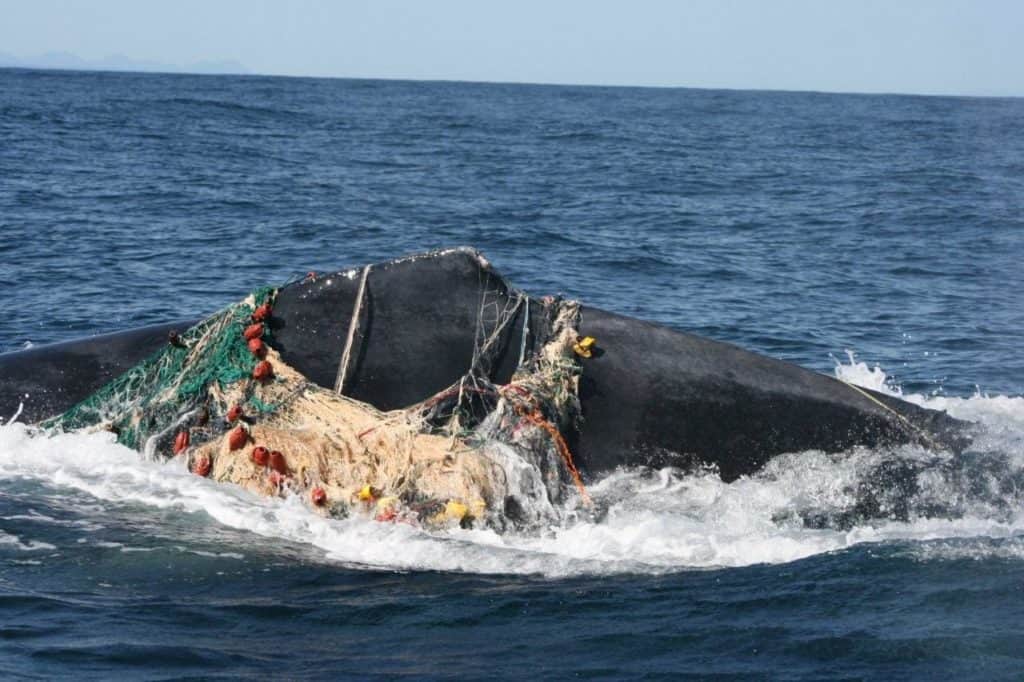
Thanks to global conservation efforts, the current population has rebounded to nearly 80,000 humpback whales up from a low point of 10,000 to 15,000.
Respiratory illness and parasites are common among stranded and deceased whales.
The species is increasing in abundance throughout much of its range but faces threats from entanglement in fishing gear, vessel strikes, vessel-based harassment, underwater noise, and bad tourism practices.
Many Humpback whales are Panamanian
Humpback Whales droppings work as fertilizer for shallow ecosystems. By fertilizing photosynthetic plankton, retain tons of carbon that would otherwise go into the atmosphere.
Whales are definitely amazing animals, we still have a lot to learn from them and how we can help to protect their environment.
We hope that the next time they visit us in Panama, you will be able to witness the great giants of Panama.
Thanks to Eduardo Estrada for sharing their incredible photos with us, follow him on @eestrada_wildlifephoto.

